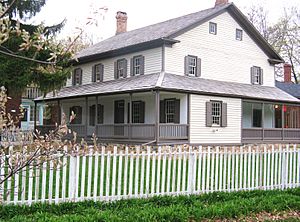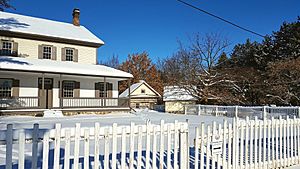Schneider Haus facts for kids
 |
|
| Lua error in Module:Location_map at line 420: attempt to index field 'wikibase' (a nil value). | |
| Established | 1981 |
|---|---|
| Location | 466 Queen Street South Kitchener, Ontario N2G 1W7 |
| Public transit access | Short walk from Charles St. Terminal (Grand River Transit) |
| Official name: Joseph Schneider Haus National Historic Site of Canada | |
| Designated: | 1999 |
The Schneider Haus National Historic Site is a special museum in Kitchener, Ontario, Canada. It used to be called Joseph Schneider Haus. This site is on land that was settled very early by people who were not Indigenous. The museum has the oldest house still standing in the area. In 1999, it was named a National Historic Site of Canada. This means it is a very important place in Canadian history.
A Look Back in Time
The Schneider Haus was once a farm. It had a house built around 1816 by Joseph and Barbara Schneider. This was in a place then called Berlin, Ontario. The Schneider family was part of a large group of Pennsylvania German Mennonites. They came from Pennsylvania to settle in Waterloo County in the early 1800s.
The First Settlers
This land was part of the German Company Tract. It was also known as Block 2 within the Haldimand Tract. This was one of the first areas in the County where non-Indigenous people settled. Bishop Benjamin Eby was part of this group. He wanted to start a new Mennonite community. This community grew into the village of Ebytown. It later became Berlin in the 1830s. After 1916, it was renamed Kitchener. Other nearby areas like St. Jacobs, Ontario and Elmira, Ontario also attracted Mennonites.
Life on the Farm
The Schneider farm was very large, about 181 hectares. The house is the oldest one still standing in Kitchener. Today, the Schneider Haus shows what life was like in Ontario in the 1850s. The house has been carefully restored to look like it did back then. There are also other old buildings on the site. These buildings help visitors imagine life in the past.
People who work at the museum dress in old-fashioned clothes. They use old tools to show how things were done long ago. This makes history feel real. The museum has over 7,000 items. These include paintings, quilts, old papers, board games, and leather items.
The house was restored and opened as a museum in 1981. The people who work there show what life was like in 1856. By then, Joseph and Barbara's children were living in the house. The Schneider Haus became a National Historic Site of Canada in 1999.
Why the Name Changed
In 2017, the Regional Municipality of Waterloo changed the museum's name. They removed "Joseph" from the name. This was done to honor the whole Schneider family. It includes Joseph's wife, Barbara, and her important contributions. It also helped avoid confusion with John Metz Schneider. He founded a food company called Schneider Foods.
See also
- List of oldest buildings and structures in the Regional Municipality of Waterloo



